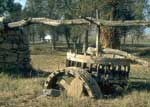 | | 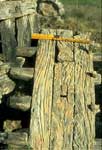 | | 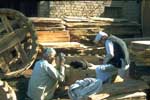 |
| |
A sâqiya made of wood, Pakistan
This sâqiya is made by an expert. Every part is made with precision and careful thought. The rungs in the lantern pinion are shaped instead of it just being a cylindrical trundle. By this method, the surface strain - between the rungs - is reduced.
[131] | | Laminated gearwheel rim in Pakistan
A gearwheel like this could only be made by means of a wood-finishing machine. The pitch (distance) from one cog to the next is very small.
[132] | | Producing a perfect gearwheel
A factory can produce a perfect gearwheel, if they have the skill and if the farmer who is going to buy the wheel has the money.
[133] |
|
 | | 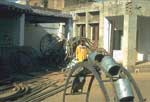 | |  |
| |
Sâqiya -wheels stored in a factory in Pakistan
The wheels are made in sets of about ten.
[134] | | A workshop in Pakistan
A pot garland-wheel made of iron. The bucket is assembled deliberately at an angle to the chain. This is because the chain is hanging aslant and the rim of the bucket should be horizontal.
[138] | | Part of a potgarland in Pakistan
Buckets made of plate metal are long lasting, compared to earthenware pots, but they are more expensive.
[140] |
|
 | | 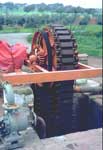 | | |
| |
Factory-made noria in Spain
This is a modern design of a two-thousand-year-old invention. The electric motor runs at about 1400 rpm but the potgarland-wheel runs at no more than 14 rpm. This reduction needs two gears. The first one is from a v-belt drive, with a ratio of about 1:10. The second from the tooth gear must have a similar ratio.
[141] | | Factory-made noria in Spain
Instead of a few big buckets, the potgarland has-many but small ones.
The small gearwheel is intended for a donkey-drive as an alternative if there is no electricity for an electric motor.
[142] | | |
|